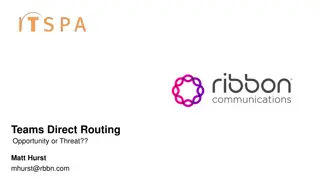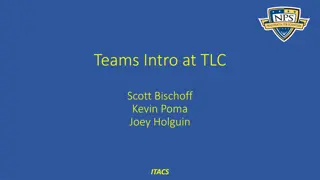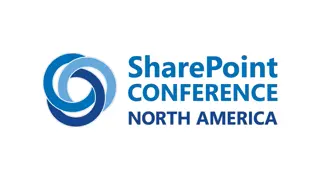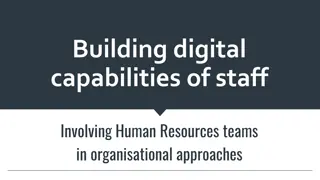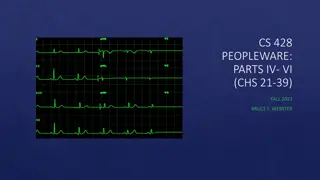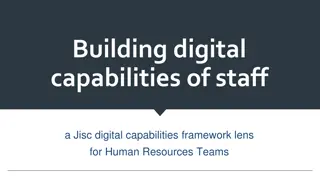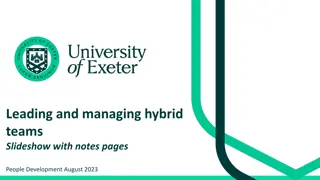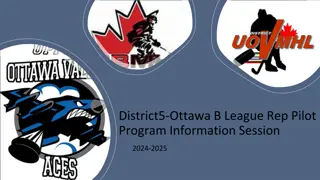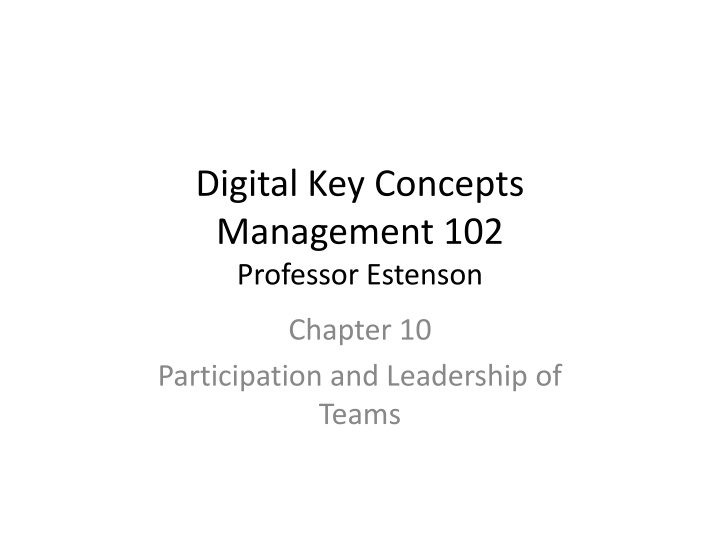
Effective Team Participation and Leadership Strategies
Discover key concepts in team management, including commitment, active listening, maintaining roles, dealing with dysfunctional behaviors, and effective leadership styles. Learn how to foster a productive team environment and enhance leadership effectiveness.
Download Presentation

Please find below an Image/Link to download the presentation.
The content on the website is provided AS IS for your information and personal use only. It may not be sold, licensed, or shared on other websites without obtaining consent from the author. If you encounter any issues during the download, it is possible that the publisher has removed the file from their server.
You are allowed to download the files provided on this website for personal or commercial use, subject to the condition that they are used lawfully. All files are the property of their respective owners.
The content on the website is provided AS IS for your information and personal use only. It may not be sold, licensed, or shared on other websites without obtaining consent from the author.
E N D
Presentation Transcript
Digital Key Concepts Management 102 Professor Estenson Chapter 10 Participation and Leadership of Teams
Commitment and Preparation Active Listening Receive whole message Accurately interpret message Check accuracy of your translation of message Repeat steps 1 through 3 until speaker is satisfied that you heard the message correctly
Commitment Continued Open minded Involve all personality types Extroverts and Introverts Agreeable Conscientious Emotionally Stable Open to New Experiences
Team Roles Task Give and Seek Information Give and Seek Opinions Elaborate Energize Review Record
Roles Continued Maintenance Encourage Harmonize Relieve Tension Gatekeeper
Dysfunctional Behaviors Blocking put downs Aggression Storytelling- get people off track Recognition Seeking Dominating Confessing- drama kings or queens Special interests outside of tasks Distracting- joking or acting out Withdrawing
Dealing With Behaviors Plan opening and meeting flow Seat people strategically Avoid making eye contact with trouble maker Assign tasks Assign speaking order Stop behavior Give praise for positive behaviors
Leadership Leadership can result in goodness or evil Leadership has three dynamics at work at same time: Context Lead Follower
Leadership Studies Behaviors Trait Function (task or people) Styles (autocratic, democratic or laissez-faire Situation Fielder (power-task-relationship) Hersey/Blanchard (tell-sell-participation-delegate) House/Aditya help people meet their needs while achieving organizational goals
Recent Vroom (decision tree approach if then either group or leader making decision) Transformation Leading from heart and with passion toward a goal bigger than self
High Risk Teams (Political, Financial, Physical) Passion of Teams From the Book: Secrets of Special Ops Leadership. General William A. Cohen. The Ether Zone by Ray Morris Articles by Jerry Estenson
Principles in high risk environments Clear purpose Repetition Speed Simplicity
Exemplary Leader Characteristics: From: Leading in High Risk Environments. Competent Honest
The down side of high-performing teams Limited Forgiveness Burn out









